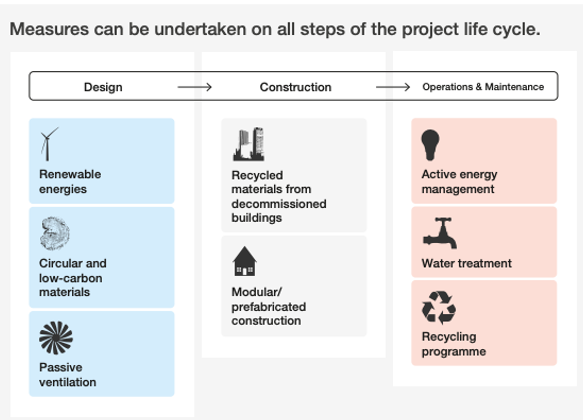Post-pandemic, the commercial real estate industry must continue to become more sustainable, hyper-efficient, people-centric and resilient.
By Annick Villeneuve, VP Real Estate at Schneider Electric
The convergence of multiple crises in 2020 – public health, social, economic, and planetary – also brought about a reckoning for the real estate industry. A global shift in perspectives brought about a unique opportunity and a clear mandate for the commercial real estate industry to transition to a more sustainable, livable future. This inspired those of us in the World Economic Forum’s global real estate community to align on a vision for commercial buildings of the future: A Framework for the Future of Real Estate.
The global commercial real estate market is expected to grow to $2774.45 billion this year, with buildings vital for our societies and economy, but COVID-19 sent some asset classes into a tailspin while accelerating other trends to a fever pitch. Some impacts are temporary, while others will continue to pose unique recovery challenges. The industry has transformed and must continue to transform in order to thrive in the future, becoming more sustainable, hyper-efficient, people-centric, and resilient.
Commercial real estate must quickly adapt to the changes that the pandemic brought nationwide. A pertinent example of rapid change is with office spaces. The pandemic changed the future of work to a hybrid model where offices will have to be flexible spaces that coexist with remote work options. In this new hybrid model, office space must evolve from a place to sit at a desk to a revitalized space to connect and share ideas. Office design can enhance the employee experience with layouts maximizing the value of in-person contact while accommodating different uses throughout the day. Research has shown a positive correlation between a comfortable environment and productivity.

To survive and even thrive, developers, owners, and operators will need to capture the power of the all-digital, all-electric world to create more sustainable, resilient, efficient, and people-centric buildings. Offices, especially, can’t overlook the need to be people-centric. For example, the National Institute of Occupational Health in Copenhagen found that people who are satisfied with their work environment are up to 15% more productive compared to those who are not. Livability in office spaces is crucial for enhancing the human work experience, often with the support of apps that support employees’ in-person and digital experiences. From focus zones to work cafes, the new office space integrates “external” elements such as coworking and the home office to create an activity-based workplace that supports people in various ways throughout their workday.
Or take retail, for example, which was severely impacted by the pandemic. Grocery retail is one of the few exceptions. Major retailers like Disney expect to close 20% of retail stores globally. Stores of the future will require flexible, quickly adaptable, and customizable spaces that respond to constantly changing customer needs. Energy management and power digitization is a key enabler of this transformation. This can also take the form of easily adjustable displays to feature new products, offering product trials in-store, or chances to share feedback on product development can help change the atmosphere. Retailers may also provide diverse in-store experiences, such as Nike allowing customers to try their running shoes on a treadmill or banks installing cafes in their branches to build their brand and attract new customers.
As businesses account for the changes in customer expectations brought on by the pandemic, we must not forget to prioritize sustainability in recovery efforts. The increased focus on public health and social good across our society means that now is an opportune time to reprioritize sustainability. Buildings account for nearly 40% of global greenhouse gas emissions. To meet net-zero carbon goals, which require abating the carbon emitted throughout the entire asset life cycle, action must be accelerated in making commercial real estate more sustainable.
Measures should aim at decreasing the energy requirements of buildings while maintaining the same level of quality so that >30% of the energy is no longer wasted in buildings. These goals can be achieved through superior thermal envelopes, glazed windows, enhanced wall insulation, and highly efficient hardware, like LED lighting. Smart digital systems can also help optimize units’ energy demand, such as smart thermostats and IoT occupancy sensors.
Energy retrofits of old buildings could help cut energy demand for heating by two-thirds or more and reduce or eliminate CO2 emissions by switching to renewables or decarbonized electricity. Using thermal energy, solar panels, and boilers that work with alternative fuels like biofuels can also help to reduce a building’s carbon footprint significantly. Since 35% of the life cycle carbon from a typical office building is emitted before the building is even opened, these sustainability efforts will also require the renovation or repurposing of buildings rather than demolition.

Sustainability efforts shouldn’t be cost-prohibitive, as numerous interventions can be made that generate cost savings. For example, many existing assets have redundant utility provisions and capacity, and the utility connectivity is not always efficient. Some design features may also help mitigate carbon emissions. We must make sure energy efficiency is not a trade-off of affordability. Assets of every type must be developed and retrofitted to move towards net zero carbon targets and ensure resilience against a variety of shocks.
The industry is evolving, but today’s global demands will push the transformation into overdrive. The COVID-19 pandemic presents a unique opportunity to accelerate the transition across all commercial real estate sectors. As offices evolve to drive collaboration and well-being, commercial real estate must leverage technology to complement online channels and drive customer experience. In all industries, the drive for more sustainable real estate decision-making must be paramount. Amid the uncertainty that COVID-19 has generated, a moment of reckoning for real estate has also come. If we rise to the challenge, real estate can flourish in the 21st-century — stronger, more adaptable, and more sustainable than before.

Annick Villeneuve is the Vice President of the Real Estate Segment and Strategic Partnerships for Schneider Electric. For more than 20 years, Annick has helped customers worldwide achieve their sustainability goals and maintain operational flexibility and efficiency while creating buildings that offer better occupant experiences. Leading a global team of sales, marketing, and solution architects, Annick is responsible for both the success of the Smart Real Estate Solutions & Services Segment, as well as the Autonomous Buildings practice.
Scott Ellyson, CEO of East West Manufacturing, brings decades of global manufacturing and supply chain leadership to the conversation. In this episode, he shares practical insights on scaling operations, navigating complexity, and building resilient manufacturing networks in an increasingly connected world.